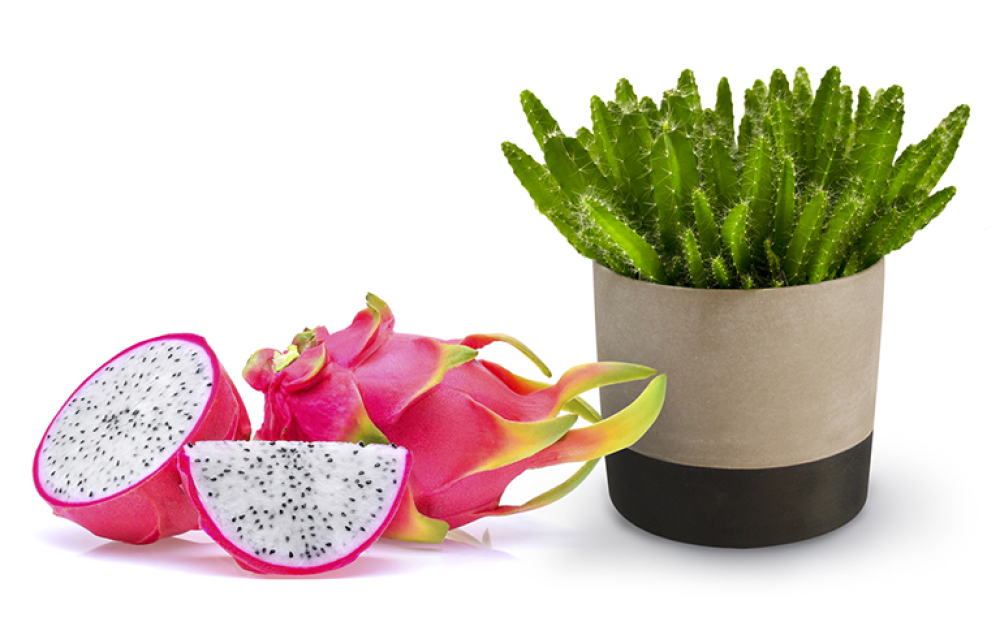
Dragon Fruit goes by many names, such as Pitahaya, Queen of the Night, Night-blooming Cereus, Moonlight Cactus, Honolulu Queen, etc. It is a tropical cactus, native to Central America and tropical and subtropical regions in Asia.
Place your plant in a light-shaded bright environment. Avoid direct sunlight as this can scorch its foliage or cause leaf damage. You can also rotate the pot every so often so that lights reaches all sides of the plant.
Dragon Fruit is a cactus from tropical and subtropical regions. It requires more water than other cacti, but still prefers to have its soil dry out slightly between waterings. We recommend bottom-watering because it enables the roots to soak up the moisture they need.
To water your Dragon Fruit from the bottom, put it in a sink or basin with an inch of water. Let it soak for 5-15 minutes. Then you can return the plant to its container and put it back in a sunny place.
You should water Dragon Fruit cactus about once every two weeks under normal conditions. You can check the soil with your finger or use a moisture meter to check how damp the soil is. The soil should feel dry or slightly damp, but never rock hard or swampy.
Repot Dragon Fruit cactus like a succulent. Choose a pot that is 1 to 2 inches wider in diameter than the existing pot. A pot with drainage holes is best to prevent the roots from becoming oversaturated with water..
You should repot the dragon fruit cactus about once every 1 to 2 years to refresh its nutrients. You may choose to repot sooner and/or separate the stems into separate pots to speed up growth.
Use a well-draining potting mix—preferably one that it formulated for succulents and cacti. You can find potting mix at any local garden centre
Place your plant in the temperature range of 12-27ºC (54-80ºF). Keep indoors, except USDA zones 10a to 11b. Do not exceed 37ºC (100ºF), or let below 0ºC (32ºF), to prevent wilting/freezing.
You can propagate your Dragon Fruit cactus by stem cuttings or by seed
To help your Dragon Fruit cactus grow better, use cactus or succulent fertilizer once a month during its growing season. Alternatively, a balanced fertilizer formulated for indoor plants will suffice.
No, our Dragon Fruit cactus is of the species Hylocereus undatus, which is different than Dog Tail cactus (Selenicereus testudo).
Our Dragon Fruit cactus is actually not one single plant, but many plants grown from seed in a single pot. Each pot is grown from hundreds of seeds. Each plant in the pot has its own roots that can be divided/repotted.
Our Dragon Fruit cactus (Hylocereus undatus) is a fruit-producing variety. It is important to note though that Dragon Fruit grown from seed, especially container-grown indoors, are notoriously slow growers and will take several years to mature (at least 5 to 7 years if grown from seed). Container-grown Dragon Fruit will also not reach the same size as their wild counterparts, which can grow 10-20ft outdoors.
Dragon Fruit cactus will bloom when it reaches maturity. This will take several years if grown from seed.
Dragon Fruit is sometimes called “Queen of the Night” because it blooms at night. In the wild, it is pollinated by moths. Indoors, it is pollinated manually by brush.
Dragon Fruit cacti are prone to growing aerial roots from their stems. They are both terrestrial (growing from the ground) and epiphytic (growing on other plants). Dragon Fruit cacti love to climb, and use their aerial roots to cling to structures and other plants as they grow.
Skinny growth from the top of the stem can be a sign that your Dragon Fruit is not getting enough sunlight and/or other nutrients that it needs to grow strong. Make sure your plant is getting plenty of sunlight. You can prune these growths using a sharp, sterile knife or scissors.
Yes! According to the ASPCA, Dragon Fruit cactus is considered non-toxic to both cats and dogs.